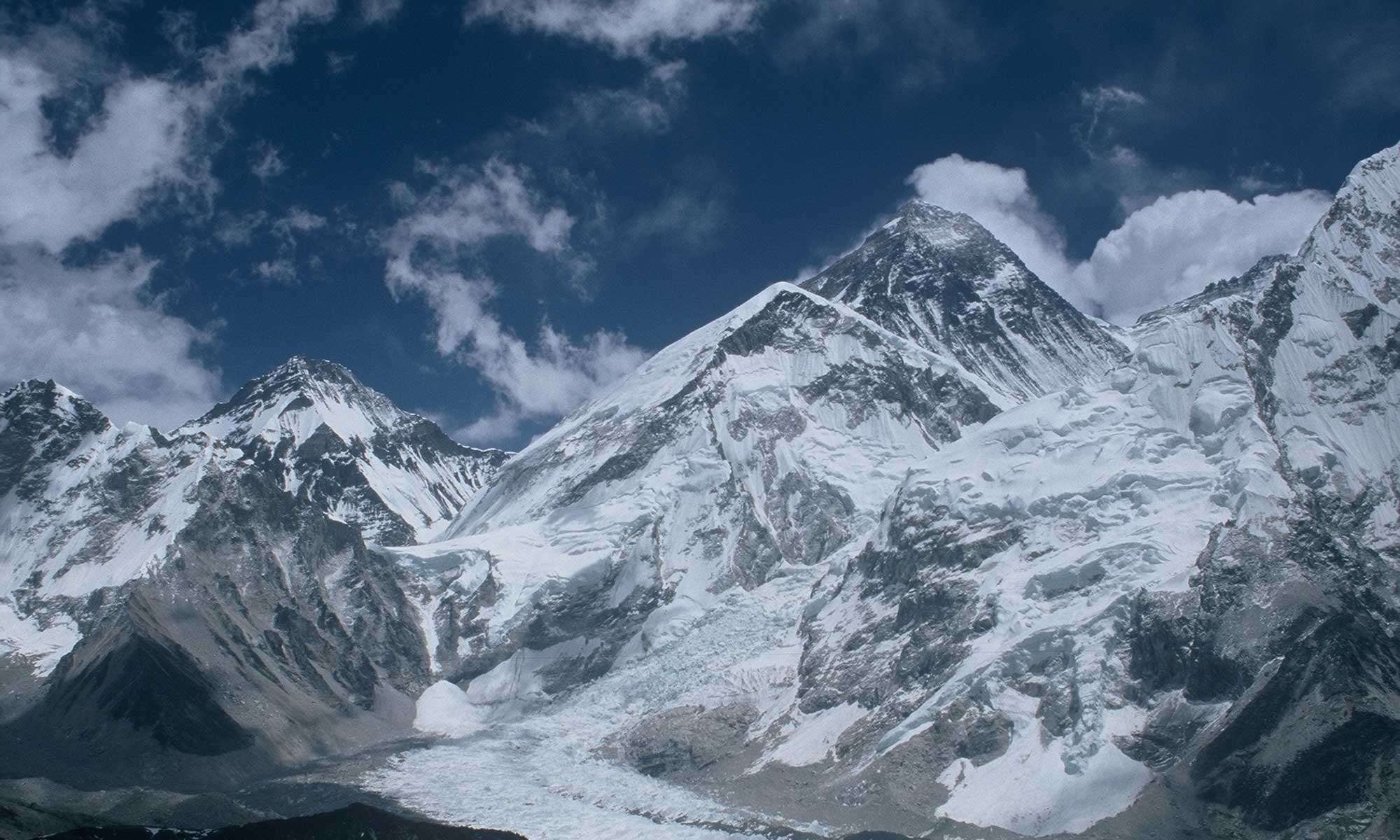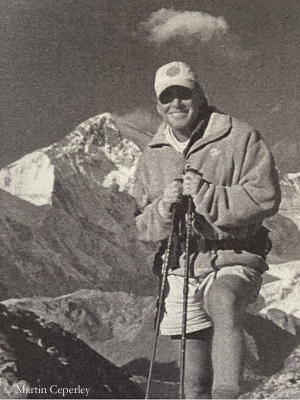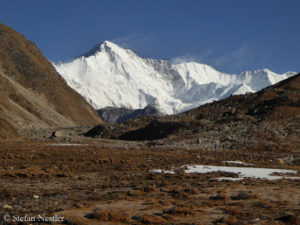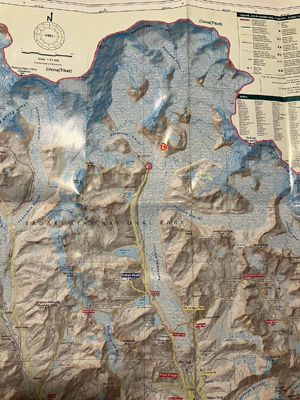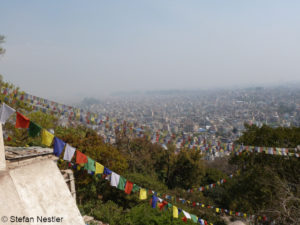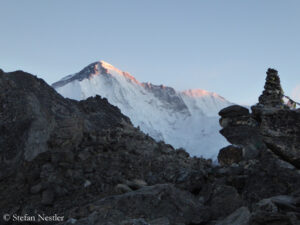Is Peter Riemann now sitting in heaven chatting with Cho Oyu, the “Goddess of Turquoise”, about his solo winter ascent of the eight-thousander in the border region between Nepal and Tibet? Probably, however, he doesn’t make much fuss about it up there either. “He was pretty private and not at all boastful about his accomplishments,” recalls the German climber’s widow, American Carol Davis. “He was fine with his own company.”
Carol is one of apparently very few people Peter let in on his secret about his alleged 1992/93 winter coup: “Peter told me, in no uncertain terms, that he summited Cho Oyu from the Nepal side, alone and without supplemental oxygen. He eschewed supplemental oxygen, and never used it. Also, Peter always climbed alone.”
No camera, no diary
Did he really succeed that winter in a milestone of Himalayan mountaineering that hardly anyone heard about? Riemann died on 4 January 2006, at his home in the small town of Lancaster in the U.S. state Pennsylvania “after a fearless and graceful battle with cancer,” as his widow wrote in the obituary. Peter took his secret from Cho Oyu to the grave. According to Carol Davis, he did not keep a diary of his mountain projects, nor did he take photos of his ascents. Apart from his equipment, he only took a Walkman with him to listen to his favorite music from Van Morrison on the mountain, Riemann’s widow said.
When he climbed mountains in Nepal or in the Indian Himalayas, he always did so without permission from the authorities, Carol writes: “He didn’t have the money for permits and, with permits he would have had to take porters, etc. And he wasn’t interested in that type of climbing. He didn’t climb for external glory. He climbed only because he wanted to.”
Aid project for Nepal
Riemann later repaid his “debt” to Nepal in other ways. With Carol, he founded the “Nepal Health Project” in 1996: they used theater performances to educate people in remote villages in Nepal about how important hygiene is for health. Carol estimates that over the years, a total of around 500,000 people attended these information events. In addition, about 15,000 eighth- and ninth-grade students had participated in workshops on first aid and basic life support. Peter had designed these workshops.
His professional training stood him in good stead. Born in 1950 in the small town of Verden in Lower Saxony, he studied sports science at the University of Bremen. He then worked as a medical educator in the town of Bremen, where he also taught first-aid courses. Riemann specialized in life-saving measures in motorcycle accidents.
Passionate ice climber
Peter was an avid motorcyclist himself. In her obituary, Carol described him as a “well-rounded athlete”. He had also been a skier, marathon runner and competitive bodybuilder. Mountaineering, however, was his great passion. It awakened rather by chance. “During a mountain vacation, he got hooked on climbing,” recalls Peter’s half-sister Ilse Bohlmann. “Then, virtually overnight, he became an amateur mountaineer. He really wanted to do something out of the ordinary.” Especially on ice, adds his widow Carol: “Peter was as much of an ice climber as anything else – he liked climbing ice the best.”
For many years, she said, he also led trekkings, in Greece, Norway, and especially in the Zanskar region of northern India. During a trekking trip together in the Indian Himalayas in 2000, Peter told her: “See that peak and that and that one? I climbed each of those.” Among them was the double peak Nun-Kun, more than 7,000 meters high, Riemann’s widow recalls.
Peter did not want to attract attention
Carol offers this explanation for the fact that Peter always climbed solo: “For one thing, I think, when he was younger, he was impacted by the story of Reinhold Messner and his brother (Günther Messner died in 1970 while descending Nanga Parbat, Reinhold survived) and other stories of climbing partners perishing. He did not know how he could live with himself if something happened to someone on a climb with him. He didn’t want to worry about anyone else, and he didn’t want anyone to worry about him either.
He knew his own skills and that he could depend on them, and he knew and pushed his own limits, and was willing to take risks with his own safety, but never wanted to put someone else at risk. For another thing, he climbed alone to attract less attention, since he was climbing without permits and porters.”
Dramatic way back to Gokyo

Carol and Peter met at Tengboche Monastery in the Everest region in 1994, the year after Riemann’s Cho Oyu winter project. He spent a month on the mountain, Peter later told his girlfriend, whom he married in 1998. He did not go into detail – for example, which route he chose, how many high camps he used or how long he needed for his summit attempt, Carol tells me. However, Peter described the dramatic last days of his expedition in great detail.
“I’m not sure why Peter told me more about that return to Gokyo than he did about the actual climb and his other climbs,” Carol says, “except that I am a trekker and not a real climber, so he knew I could relate better to that part of his expedition – and because we were in Gokyo together and walked to the lakes.”
After returning to his base camp from the summit, it began to snow, Carol recalls Peter saying. “He decided to stay in his tent to wait out the storm rather than start walking back to Gokyo. But it kept snowing almost all the time, for four days and nights, I think – it was January after all.” Again and again, Peter shoveled the tent free, she said. Eventually, however, the snow got too deep and he ran out of food.
Everything left behind
“So, finally, he started to head out, but he was sinking too deeply into the snow and was exhausted by breaking trail and always sinking in. So, he dumped a bunch of equipment, like his stove, tent, etc. and began to kind of swim, spreading out his body as much as possible so as to limit sinking into the snow.” Eventually, Carol says, Peter also left his backpack behind and continued walking only in his down suit, gloves and mountain boots.
“Progress was extremely slow and he was cold. Sometimes, while kind of swimming through the snow, he would go to sleep and he said he didn’t want to wake up, didn’t want to get up, and was fine just staying where he was, in the snow, and he would stay there and rest a long time. But a small voice inside of him would tell him that that was the way to die and he had to keep trying.” After four days he reached Gokyo Resort at night, the only lodge there at the time.
The owners of the lodge, Mr. and Mrs. Sharma, provided Peter with hot food and drinks. They may also have lent him some money, since he had left his wallet behind with his backpack, Carol suspects: “He told them that, in exchange, they could go get his stuff when the snow melted and could have it.” The following year, she says, Riemann discovered his tent and other gear in a store in Namche Bazaar, the main village of the Khumbu region. When he subsequently visited the Sharmas in Gokyo, lodge owner Surendra returned Peter’s wallet to him, “complete with all the cash in it”, recalls Carol.
Food for three weeks
The Sharmas still remember the German climber. “Peter was close to my parents and he had been to Gokyo several times and also had trying to summit Cho Oyu two or three times before,” Sonam Sharma, the couple’s younger son, writes to me. “He told my parents that he had already found the route and in winter he would be able to summit it. They said, it was maybe around January 1993.”
Riemann had taken food with him for three weeks at that time. If he did not show up after three weeks, they were to look for him, the Nepalese couple said. “When he didn’t return, my parents went and rescued him back to Gokyo,” Sonam Sharma writes. So in this detail the Sharmas’ memory differs from Carol’s, but not in the essential statement: “As Peter told my parents, he did summit Cho Oyu that year.”
Where was his base camp?
I asked Sonam to have his parents draw Riemann’s base camp on a map of the Gokyo Valley to get an idea of which route he might have chosen. “Peter once told them there were two base camps. One was before crossing the glacier and another after,” Sharma replied.
I presented the plotted points to Alois Furtner. The Austrian, together with his compatriot Edi Koblmüller, had succeeded in 1978 in making the first ascent of the 3,000-meter-high Southeast Face of Cho Oyu – incidentally, also without a permit from the Nepalese authorities.
“These camps are not a reasonable starting point for a Cho Oyu ascent,” Alois replied. Perhaps, so my assumption, these two places were not Riemann’s campsites at all. It could also be that Peter wanted to inform the Sharmas about where he had left first material, then his backpack on his way back to Gokyo – so that they could get the equipment later.
Frostbite on toes
According to Riemann’s family, Peter suffered frostbite on his toes from his adventure on Cho Oyu. “He reported problems when climbing, saying he didn’t have the right footwear,” recalls half-sister Ilse. Back in Kathmandu, he immediately went to the hospital, Carol adds: “The doctors told him that they’d need to cut off his toes because they were blackened with frostbite.”
Peter refused, she says, and was flown back home after mediation by the German embassy in Kathmandu. Riemann’s father paid for the flight. Afterwards, according to his family, Peter went to the Roland Clinic in Bremen, where his frostbite was treated. The hospital is a specialist clinic for reconstructive surgery. It is not possible to determine exactly when Riemann was admitted there. According to the clinic management, the retention period for the files from that time has expired.
At first, says Carol, it looked as if a big toe would have to be amputated. “After about four weeks in the hospital, though, they finally saw some pink where there had only been black, so they didn’t cut off the toe, they just trimmed it a bit. So Peter had a very skinny big toe and his feet were always freezing, when we were in cold places, or skiing or anything like that.”
It remains a puzzle
Did Peter Riemann really reach the summit of Cho Oyu in January 1993 – via the technically so demanding and therefore rarely climbed south side of the eight-thousander, solo, without bottled oxygen? It would have been the second solo winter ascent of this mountain, an outstanding alpinistic achievement. The first ever solo winter ascent of an eight-thousander was made in 1988 by the Spaniard Fernando Garrido, without breathing mask, via the Tibetan normal route of Cho Oyu. Three years before, in 1985, the Poles Maciej Berbeka and Maciej Pawlikowski had succeeded in the first winter ascent of this eight-thousander, on the Nepalese side via the Southeast Pillar.
In February 1993 – the same winter in which Riemann was en route – five Spaniards, an Argentine and the Swiss Marianne Chapuisat reached the summit at 8,188 meters, like Garrido via the Tibetan normal route, without bottled oxygen and without Sherpa support. Marianne was the first woman to succeed in an eight-thousander winter ascent. The team set up base camp on 13 January 1993 – comparatively low at 5,070 meters, still on the Nepalese side of Nangpa La, the mountain pass to Tibet. The reason was large amounts of snow – possibly from the days when Peter Riemann had experienced his odyssey back to Gokyo.
Since there seems to be no evidence in any form of his summit success, his ascent will probably always remain a mystery and be doubted. I have been able to put together a few pieces of the puzzle, a shadowy picture can be discerned. Too little to be certain.
Should an amateur mountaineer from the north of Germany really have achieved in a solo climb what even a high-caliber expedition had failed to do ten years earlier, in the winter of 1982/83 – with top climbers of the time such as the Pole Voytek Kurtyka and the South Tyroleans Reinhold Messner, Hans Kammerlander and Hanspeter Eisendle? On the one hand, this sounds completely absurd. And one is tempted to think Riemann is one of those impostors on the mountain, of which there were and are a few in the history of high-altitude mountaineering.
On the other hand, why should the passionate ice climber have lied, if he – as his relatives unanimously describe it – only climbed mountains for himself, was completely unpretentious and without any urge to communicate, a loner only in search of his personal mountain adventure? What would he have gained from telling the untruth? Maybe some recognition from the few people he had told about his ascent, but otherwise? Nothing.
Ashes at the foot of Cho Oyu
Less than a year after Peter died of lung cancer, Carol Davis brought her late husband’s ashes to Nepal. A nun at Thamo Monastery near Namche Bazaar pressed some of the ashes into two little relics and told her to place one in a river and one in the mountains. “So I did one puja (Buddhist prayer ritual) near a secluded river before I got back to Namche leaving one there,” Carol writes me.
The second one she brought to Gokyo. Surendra Sharma and a kitchen boy accompanied her to the site of Peter’s alleged Cho Oyu base camp, Riemann’s widow says. There, too, she did her own puja for her late husband, on Christmas Day, according to the Tibetan calendar exactly one lunar year after Peter’s death – “crying into the wind and missing him terribly. I heard his deep beautiful voice within me say, ‘there is nothing for you here, go back to the living!'”
P.S. I would like to thank Rodolphe Popier for the impetus for this story, the South Korean climber Young-Hoon Oh for initial information, and especially Carol Davis, the Bohlmann family in Verden and the Sharma family in Gokyo for their support in my research.
